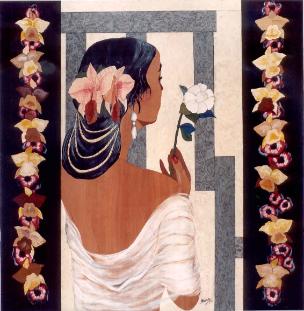
All rights reserved to Cristina Alvarez Magliano - Copyright ©2013

| The site of Cristina Alvarez Magliano Fine Art in Marquetry |
These series include portraits of one or more operatic characters in a particular moment or, eventually, just a synthesis of several themes of import in the music and staging of famous operas. In some cases, I have adapted my style to art movements contemporary with the time period in which the opera is set, or I have combined representational and figurative design with abstract backgrounds. However most of the characters are of European origins (French, Italian, German, etc.) from the XIX and beginning of XX Century, I paid also a lot of attention to an Argentinean composer whose music I admire and love, Astor Piazzola. In 1968’s he wrote an opera called “Maria de Buenos Aires” a tangopera (‘operita’ he said) where Maria personifies tango: her cradle lies on the banks of the vast delta of the Rio de la Plata. That element has a significant empathy with my way of viewing things, as I have always been very fond of dramatic female characters and music. Maybe this is due to the first defining experiences I had as a young woman in the early years of the cold war, trying to find her identity in a small town outside Buenos Aires. To fall in love for the first time thinking about the atheist existentialism of Jean Paul Sartre and the strength of Simone de Beauvoir is not common to all generations; later generations fell in love while dancing to the Beatles, that is to say, with much more lightness and less heaviness in the heart, but not less affectionately, tenderly or without goodness. Only, in my imagination at least, with less melodrama. On the other hand, to grow up surrounded by traditional tango music translates into a vision of women stereotypes that ranges from a sacrificed mother dying in poverty to a streetwalker destroying a man’s life for money. For all that reasons the later works in the series depict women that are light, funny and, at the same time, very provocative and sexy. None of them are real women. My pieces depict a partial vision, among many, that come from a rich existence. But, actually, adversity, intense passion, and other- worldly acts of courage by women all over the world are not only within de realm of fiction. I present only one -and very personal- point of entry into that profound appreciation of womanhood which can be shared by men and women alike. |
| "Women in the Opera" and "Objects of Desire" |
|
|
|
|
"Turandot" Four pieces screen for a table.
The premiere of Turandot was at La Scala, Milan, on Sunday 25 April
1926, one year and five months after Puccini's death (he left it
unfinished),conducted by Arturo Toscanini. The story of Turandot was
taken from a Persian collection of stories called The Book of One
Thousand and One Days, where the character of "Turandokht" as a cold
princess was found. She confronted her suitors with three riddles. The
suitor had to forfeit his life if he failed to answer correctly. Three
ministers,Ping,Pang and Pond, work for the Princess, and the three
words for Calaf (the Unknown Prince that correctly answers the riddles)
are 'Hope', 'Blood' and 'Turandot'. The famous aria 'Nessun dorma...'
belongs to the third act; was sung by tenors from Mario DelMonico and
Franco Corelli to Luciano Pavarotti and Placido Domingo.
The premiere of Turandot was at La Scala, Milan, on Sunday 25 April
1926, one year and five months after Puccini's death (he left it
unfinished),conducted by Arturo Toscanini. The story of Turandot was
taken from a Persian collection of stories called The Book of One
Thousand and One Days, where the character of "Turandokht" as a cold
princess was found. She confronted her suitors with three riddles. The
suitor had to forfeit his life if he failed to answer correctly. Three
ministers,Ping,Pang and Pond, work for the Princess, and the three
words for Calaf (the Unknown Prince that correctly answers the riddles)
are 'Hope', 'Blood' and 'Turandot'. The famous aria 'Nessun dorma...'
belongs to the third act; was sung by tenors from Mario DelMonico and
Franco Corelli to Luciano Pavarotti and Placido Domingo.
|
"Objects of Desire"
"Frou-Frou"
"Orchid Girl"
"Temptation Girl"
" Yoga Meditation"
|
|
|
For the beautiful music of any of these operas, in multiple editions, the best singers and
conductors, you can have CDs or DVDs, at very reasonable prices, at ArkivMusic.com. To
visit this site, please, click HERE.
conductors, you can have CDs or DVDs, at very reasonable prices, at ArkivMusic.com. To
visit this site, please, click HERE.



















